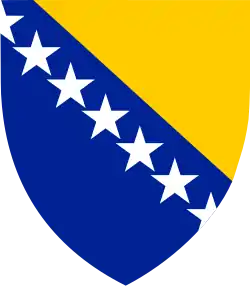Political divisions of Bosnia and Herzegovina
The political divisions of Bosnia and Herzegovina were created by the Dayton Agreement. The Agreement divides the country into two federal entities: the Federation of Bosnia and Herzegovina (FBiH) and the Republika Srpska (RS) and one condominium named the Brčko District.
| Political divisions of Bosnia and Herzegovina Politička podjela Bosne i Hercegovine Политичка подјела Босне и Херцеговине | |
|---|---|
.svg.png.webp) Political divisions of Bosnia and Herzegovina: Republika Srpska entity (1), Federation of Bosnia and Herzegovina entity (2), Brčko District condominium (3) | |
| Category | Federated state |
| Location | |
| Created | |
| Number | 2 entities and 1 condominium |
| Populations | 85,000 (Brčko District) – 2,243,000 (Federation of Bosnia and Herzegovina) |
| Areas | 493 km² (Brčko District) – 26,110.5 km² (Federation of Bosnia and Herzegovina) |
The Federation of Bosnia and Herzegovina (FBiH) is composed of mostly Bosniaks and Croats, while the Republika Srpska (RS) is composed of mostly Serbs.
Each entity governs roughly one half of the state's territory. The Federation of Bosnia and Herzegovina itself has a federal structure and consists of 10 autonomous cantons.
Overview
The Federation and the Republika Srpska governments are charged with overseeing internal functions. Each has its own government, flag and coat of arms, president, legislature, police force, customs, and postal system. The police sectors are overseen by the state-level ministry of safety affairs. Since 2005, Bosnia and Herzegovina has had one set of Armed forces.
The Inter-Entity Boundary Line is not determined by natural geographical features of the country. It rather follows the military front-lines as they were at the end of the Bosnian War. On the ground, there is no active border between RS and FBiH, and one would generally not know the difference when crossing from one entity into another.
The city of Brčko in northeastern Bosnia is a seat of the Brčko District, a self-governing administrative unit; it is part of both the Federation and Republika Srpska. The district remains under international supervision.
The Federation is further divided into ten cantons, which are then subdivided into municipalities. The Republika Srpska is divided directly into municipalities.
List
| Name | Area (km2) | Pop. | Ethnic groups | Munic. | Status | Map |
|---|---|---|---|---|---|---|
| Federation of Bosnia and Herzegovina Federacija Bosne i Hercegovine Федерација Босне и Херцеговине |
26,110.5 | 2,243,000 | Bosniaks (70.40%) Croats (22.44%) Serbs (2.55%) |
79 (including 22 cities) |
Entity |  |
Република Српска Republika Srpska |
24,532.8 | 1,209,000 | Serbs (82.95%) Bosniaks (12.69%) Croats (2.27%) |
64 (including 10 cities) |
Entity |  |
Brčko Distrikt Брчко Дистрикт |
493 | 85,000 | Bosniaks (42.36%) Serbs (34.58%) Croats (20.66%) |
— | Self-governing district |
 |
References
Further reading
- Bahtić-Kunrath, Birgit (2011). "Of veto players and entity-voting: institutional gridlock in the Bosnian reform process". Nationalities Papers. 39 (6): 899–923. doi:10.1080/00905992.2011.614224. ISSN 0090-5992. S2CID 153850550.
- Belloni, Roberto (2009). "Bosnia: Dayton is Dead! Long Live Dayton!". Nationalism and Ethnic Politics. 15 (3–4): 355–375. doi:10.1080/13537110903372367. hdl:11572/76874. ISSN 1353-7113. S2CID 143858915.
- Bose, Sumantra (2005). "The Bosnian State a decade after Dayton". International Peacekeeping. 12 (3): 322–335. doi:10.1080/13533310500074028. ISSN 1353-3312. S2CID 145810090.
- Cooley, Laurence (2013). "The European Union's approach to conflict resolution: Insights from the constitutional reform process in Bosnia and Herzegovina". Comparative European Politics. 11 (2): 172–200. doi:10.1057/cep.2012.21. ISSN 1472-4790. S2CID 144140751.
- Hayden, Robert M. (2005). ""Democracy" without a Demos? The Bosnian Constitutional Experiment and the Intentional Construction of Nonfunctioning States". East European Politics and Societies and Cultures. 19 (2): 226–259. doi:10.1177/0888325404272679. ISSN 0888-3254. S2CID 145709568.
- Keil, Soeren; Kudlenko, Anastasiia (2015). "Bosnia and Herzegovina 20 Years after Dayton: Complexity Born of Paradoxes" (PDF). International Peacekeeping. 22 (5): 471–489. doi:10.1080/13533312.2015.1103651. ISSN 1353-3312. S2CID 146390988.
- Perry, Valery (2015). "Constitutional Reform in Bosnia and Herzegovina: Does the Road to Confederation go through the EU?". International Peacekeeping. 22 (5): 490–510. doi:10.1080/13533312.2015.1100082. ISSN 1353-3312. S2CID 151456221.
- Sebastian, Sofia (2009). "The Role of the EU in the Reform of Dayton in Bosnia-Herzegovina". Ethnopolitics. 8 (3–4): 341–354. doi:10.1080/17449050903086948. ISSN 1744-9057. S2CID 143308393.
- Touquet, Heleen; Vermeersch, Peter (2008). "Bosnia and Herzegovina: Thinking Beyond Institution-Building". Nationalism and Ethnic Politics. 14 (2): 266–288. doi:10.1080/13537110801985120. ISSN 1353-7113. S2CID 144848639.
